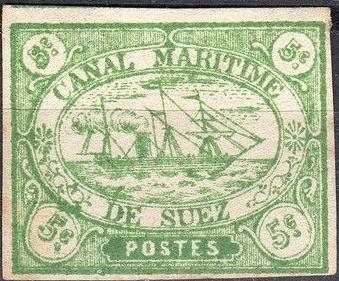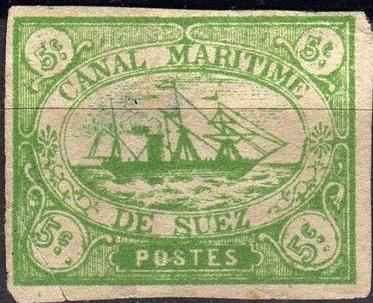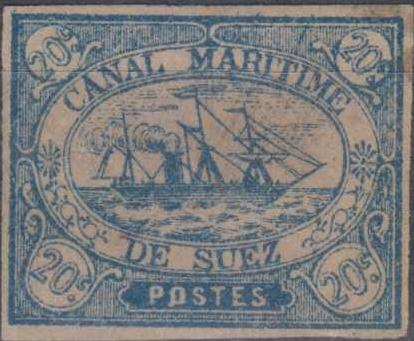



Return To Catalogue - Suez Canal Company (Egypt) - Suez Canal Company, forgeries part 1 - Suez Canal Company, forgeries part 2
Note: on my website many of the
pictures can not be seen! They are of course present in the cd's;
contact me if you want to purchase them: evert@klaseboer.com.
ATTENTION: most of the stamps found in collections are forgeries! This must be one of the most forged areas in philately. More than 20 different forgeries seem to exist of these stamps! Most forgeries require careful comparison with a genuine stamp, but with a little practise, most forgeries can be easily detected. For more forgeries: Suez Canal Company, forgeries part 2.
How to detect the forgeries? Firstly we can check the space between 'POSTES' and the oval. On most forgeries, the shading is vertical lines only. The real issues have cross-hatching:

(Genuine stamp with cross-hatching)
Gum at the back is almost always cracked, forgeries don't have this, they always almost have smooth white gum (or no gum at all):

(Backside of a genuine 20 c, reduced size)
I found the following information at http://www.geocities.com/dr_k_fleming/suez.htm:
If your examples show any of the following characteristics, they are forgeries.
Perforated (the originals were imperforated) No cross hatching above POSTES smooth, colourless gum (a forgery if not a regummed stamp) thin, hard paper tan paper shiny ink (genuine stamps are matt) corner guide lines outside the design continuous guidelines between the stamps flat tops to the letters A any number of rays other than 12 in the star-like ornaments smoke from the funnel touches the oval frame circular cancellation of any kind (other than the Suez grid)

(The deck of a genuine stamp, image from R.J. Wilson)
I've been told that the stamps shown below are Spiro forgeries. Spiro forgeries can in general be recognized very easily by their 'strange' cancels (for example the New South Wales cancel or a dotted cancel, although the dotted cancel also appears on other forgeries) or when the margins are large enough, by their guidelines between the stamps. The design though is rather accurately copied for these Spiro forgeries. Spiro forgeries are produced in sheets of 5x5 stamps. Also the 'C' of 'CANAL' is too closed at the right hand side.

Spiro sub-type A: the left hand '1c' is slanting too much and
there is a break in the circle surrounding this '1c' at 10
o'clock. The '1c' is also placed lower.

Dubious item with the two 'S' in 'POSTES' different from a
genuine stamp. Most likely a Spiro forgery as well.
One type forgery
Forgeries, very similar to those of Spiro, however, printed in sheets of 120 stamps, and small design differences. These forgeries are also very similar to the 'three-type forgeries'. They might have been copied from the Spiro forgeries by another forger.




Forgeries, very similar to the Spiro forgeries. These forgeries
have a line through the upper part of the 'D' of 'DE' connecting
it to the sea.
Three different types exists of this forgery, which were printed together on one sheet. There is an extra dot (passenger) just before the last mast in these forgeries. Between 'DE SUEZ' and 'POSTES' are only vertical lines. These forgeries were printed in sheets of 120 stamps (10 rows of 12 stamps). Often, there seems to be a scratch starting from the top of the 'T' of 'MARITIME' slanting forwards towards the outer frameline. The second 'S' of 'POSTES' is slanting backwards. At first sight, they look very similar to Spiro forgeries.


Type A of the 1 c: This forgery of the 1 c shows in the upper
left value tablet still some unerased 'c.' parts.



Type B of the 1 c: the bowsprit has a scratch through it. The
block of two stamps originates from the third row on the sheet;
the last stamp has a thick line through the 'S' of 'SUEZ' (always
in this position of the plate?).


Type C of the 1 c: there is a large extra dot in front of the
lower right '1c'.

Two C-types (top) and two B-types (bottom) printed together.

Type B of the 5 c; there is an extra dot in the bottom left '5c'
label.


Type C of the 5 c; the left frameline has a thickening (next to
the lower part of the upper left ornament).

Two Type C stamps of the 5 c (top row) and two Type A stamps
(bottom row). Type A has a dot in front of the '5' in the lower
left corner.


The 20 c also has three types, but they are not easy to
distinguish, except for Type C (the above are Type B?).


Type A of the 20 c(?); it has a very tiny dot in front of the
bowsprit.

Type C of the 20 c (twice); there is a blob of ink below the 'D'
of 'DE'.



Type A of the 40 c: dip in the bottom of the upper right value
tablet, to the left of the '4'


Type B of the 40 c; faint large dot under the right hand side
'40'.

Type C of the 40 c; this forgery has a 'knob' on the left top
side of the '0' of the upper right '40'.

Two types B (top) and two types C (bottom row)

Note the small line below the upper left '5'.
The above forgery also has some Spiro characteristics, but I have not been able to determine where it belongs exactly.
Literature:
Unfortunately I haven't been able to read any of the above books or articles.
Websites: